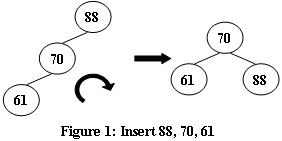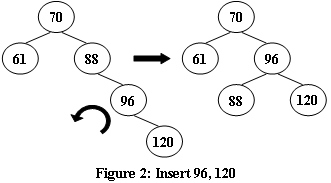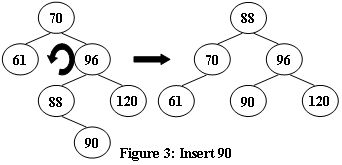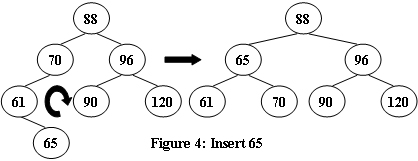An AVL tree is a self-balancing binary search tree. In an AVL tree, the heights of the two child subtrees of any node differ by at most one; if at any time they differ by more than one, rebalancing is done to restore this property. Figures 1-4 illustrate the rotation rules.
 |  |
|---|---|
 |
 |
Now given a sequence of insertions, you are supposed to output the level-order traversal sequence of the resulting AVL tree, and to tell if it is a complete binary tree.
Each input file contains one test case. For each case, the first line contains a positive integer N (≤ 20). Then N distinct integer keys are given in the next line. All the numbers in a line are separated by a space.
For each test case, insert the keys one by one into an initially empty AVL tree. Then first print in a line the level-order traversal sequence of the resulting AVL tree. All the numbers in a line must be separated by a space, and there must be no extra space at the end of the line. Then in the next line, print YES if the tree is complete, or NO if not.
5
88 70 61 63 65
70 63 88 61 65
YES
8
88 70 61 96 120 90 65 68
88 65 96 61 70 90 120 68 NO
毕竟是第一次做平衡二叉树,
平衡二叉树,一开始以为很难,最后看看也不过如此,我代码还是在平板上写的。
1 #include <iostream> 2 #include <cmath> 3 #include <vector> 4 #include <algorithm> 5 #include <queue> 6 using namespace std; 7 struct Node { 8 int val; 9 Node *left, *right; 10 } *tree; 11 int n, m; 12 13 Node *leftrotate(Node * tree) { 14 Node *temp = tree->left; 15 tree->left = temp->right; 16 temp->right = tree; 17 return temp; 18 } 19 20 Node *rightrotate(Node * tree) { 21 Node *temp = tree->right; 22 tree->right = temp->left; 23 temp->left = tree; 24 return temp; 25 } 26 27 Node *rightleftrotate(Node * tree) { 28 tree->left = rightrotate(tree->left); 29 return leftrotate(tree); 30 } 31 32 Node *leftrightrotate(Node * tree) { 33 tree->right = leftrotate(tree->right); 34 return rightrotate(tree); 35 } 36 37 38 int getlen(Node * root) { 39 if (root == NULL) 40 return 0; 41 return max(getlen(root->left), getlen(root->right)) + 1; 42 } 43 44 Node *insert(Node * tree, int val) { 45 if (tree == NULL) { 46 tree = new Node(); 47 tree->val = val; 48 } else if (val < tree->val) { 49 tree->left = insert(tree->left, val); 50 int ll = getlen(tree->left), rr = getlen(tree->right); 51 if (ll - rr >= 2) { 52 if (val < tree->left->val) 53 tree = leftrotate(tree); 54 else 55 tree = rightleftrotate(tree); 56 } 57 } else if (val > tree->val) { 58 tree->right = insert(tree->right, val); 59 int ll = getlen(tree->left), rr = getlen(tree->right); 60 if (rr - ll >= 2) { 61 if (val > tree->right->val) 62 tree = rightrotate(tree); 63 else 64 tree = leftrightrotate(tree); 65 } 66 } 67 return tree; 68 } 69 vector<int> v, vt; 70 void output(Node *root, int x){ 71 if(root != NULL){ 72 output(root->left, x<<1); 73 //cout <<root->val<<endl; 74 output(root->right, (x<<1)+1); 75 }else{ 76 v.push_back(x); 77 } 78 } 79 80 void levelout(Node *root){ 81 queue<Node*> q; 82 q.push(root); 83 Node *ans; 84 while(!q.empty()){ 85 ans = q.front(); 86 q.pop(); 87 vt.push_back(ans->val); 88 if(ans->left != NULL) 89 q.push(ans->left); 90 if(ans->right != NULL) 91 q.push(ans->right); 92 } 93 } 94 95 int main() { 96 cin >> n; 97 for (int i = 0; i < n; i++) { 98 cin >> m; 99 tree = insert(tree, m); 100 } 101 levelout(tree); 102 for(int i = 0; i < vt.size(); i++){ 103 printf("%d%c",vt[i], i == vt.size()-1?‘\n‘:‘ ‘); 104 } 105 output(tree,1); 106 sort(v.begin(), v.end()); 107 for(int i = 1; i < v.size(); i++){ 108 if(v[i-1]+1 != v[i]){ 109 cout << "NO" << endl; 110 return 0; 111 } 112 } 113 cout << "YES" << endl; 114 return 0; 115 }
1123 Is It a Complete AVL Tree (30 分)
原文:https://www.cnblogs.com/zllwxm123/p/11329677.html